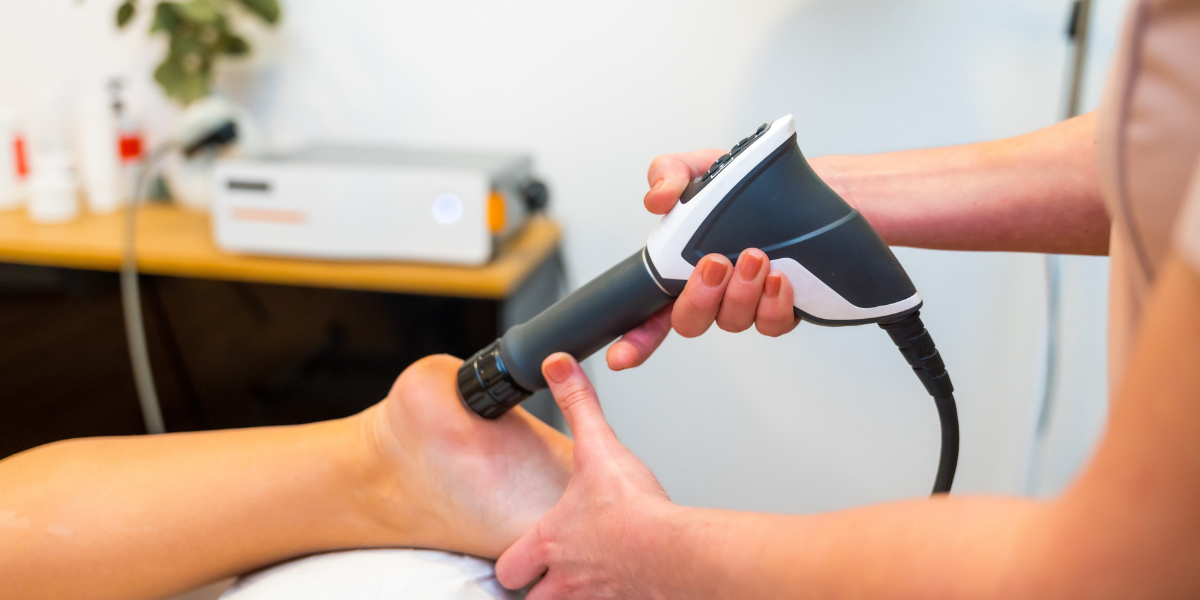
Shockwave Therapy for Plantar Fasciitis: A Physical Therapy Perspective
|
|
|
Read in 5 min
Get free shipping on orders over {{threshold}}!
|
|
|
Read in 5 min
Plantar Fasciitis is one of the most common causes of heel and arch pain. Physical therapists see many patients who have tried stretches, orthotics, and even cortisone shots for Plantar Fasciitis with mixed results. One treatment, extracorporeal shockwave therapy (ESWT), has become popular in recent years. Let’s break down what shockwave therapy does, why it’s sometimes recommended for Plantar Fasciitis, who it works best for, and how it compares to physical therapy.
Shockwave therapy is a non-invasive treatment for sports injuries and chronic pain conditions that affect soft tissue, like Tennis Elbow, Plantar Fasciitis, Achilles Tendonitis, or Bursitis. Invented in the 60s, shockwave therapy applies acoustic waves to the injured muscle or tendon through the skin.
Research has indicated that shockwave therapy has several therapeutic benefits:
In shockwave therapy for Plantar Fasciitis, the clinician uses a wand to apply acoustic waves to the plantar fascia, the thick band of tissue at the bottom of your foot that gets aggravated from overuse.
These high-energy waves create tiny, controlled injuries in the tissue that kickstarts the body’s natural healing response. In short, shockwave therapy is used to nudge the plantar fascia to move from a chronically inflamed, aggravated state into an active healing phase.
Plantar Fasciitis is an overuse injury of the plantar fascia, a ligament that maintains the shock-absorbing spring of the arch of your foot. When the amount of load and stress that goes through your foot exceeds the capacity of your muscles and tendons, plantar fascia can develop tiny tears. These tears cause pain, and eventually become scar tissue, which causes pain and tightness.
Scar tissue is weaker than healthy tissue, so you end up with even less capacity to tolerate the stress of walking, running, or standing.
To heal Plantar Fasciitis, you need to focus on transforming this problematic tissue, and that’s where shockwave therapy comes in: it’s a trigger for the body to restart the healing process in the injured plantar fascia.
Studies suggest that 44-80% of patients experience pain reduction after a course of shockwave therapy. Studies have also found a wide range of efficacy, however, which suggests that it brings symptom relief for some people but not others. This is one major downside of this treatment; you don’t know if it’ll work for you, until you try.
This can be a hard pill to swallow, given the high cost of the treatment and spotty insurance coverage (the cost of shockwave therapy can be in the thousands without insurance).
It may take a few weeks after treatment until you feel the full effect, since healing takes time. Many people who receive shockwave therapy report a quick decline in pain levels, but some of them have their pain come back after a period of time - and again, we don’t have a great way to tell which bucket you’ll fall into.
Shockwave therapy is usually not the first line of treatment. Most people try conservative approaches first to treat Plantar Fasciitis: stretching, strengthening exercises, soft tissue mobilization (massage), proper footwear, and sometimes orthotics or taping. Podiatrists and orthopedic doctors consider shockwave therapy if symptoms linger despite these first-line treatments.
Alleviate Plantar Fasciitis System 2 is a good first-line treatment, letting you easily replicate the best practices of physical therapy for quick pain relief and lasting recovery.
Shockwave therapy is usually not associated with serious side effects. That said, it’s not recommended for people who are pregnant, have bleeding (clotting) disorders, or have nerve or vascular disease in the area.
Physical therapy is still the gold standard for treating the root cause of Plantar Fasciitis. In physical therapy, you’ll use three methods together to resolve the root cause of your pain:
Load management with taping or a Plantar Fasciitis brace: reduce the load on the injured tissue as you go about your day, so that you get quick Plantar Fasciitis pain relief and your plantar fascia has time and space to start healing
Soft tissue mobilization with Plantar Fasciitis massage: encourage the growth of healthy, strong tissue by breaking up scar tissue and promoting tissue healing
Progressive strengthening (Plantar Fasciitis exercises): build strength throughout your kinetic chain, so that your plantar fascia is well supported to tolerate the stress of walking, running, and standing; this is key to preventing recurrences
Physical therapy is designed to correct the deficiency that led to the development of Plantar Fasciitis in the first place. Shockwave therapy, in contrast, is more of a “jumpstart” to tissue healing, and it doesn’t necessarily address the underlying biomechanical issues, so it's not surprising that some people see pain return after a while.
Some people get shockwave therapy while continuing with physical therapy, and there is some evidence that the combination approach is the most effective, especially on the longer-term basis.
How it works for Plantar Fasciitis: using acoustic waves, this non-invasive treatment creates tiny injuries in plantar fascia to jumpstart the healing process and reduce pain.
Efficacy of shockwave therapy: 44-80% of people get significant pain relief. However, an evidence-based way to determine if you'll get relief or if it'll stick doesn't exist, complicating your decision to pursue this treatment.
Cost of shockwave therapy: it can be expensive, with costs averaging around $1,000 without insurance. Coverage is also spotty.
Combination approach: some studies indicate that using both shockwave therapy and physical therapy can be beneficial. Shockwave therapy can bring quick pain relief, while PT helps transform the problematic tissue and prevent recurrences.

